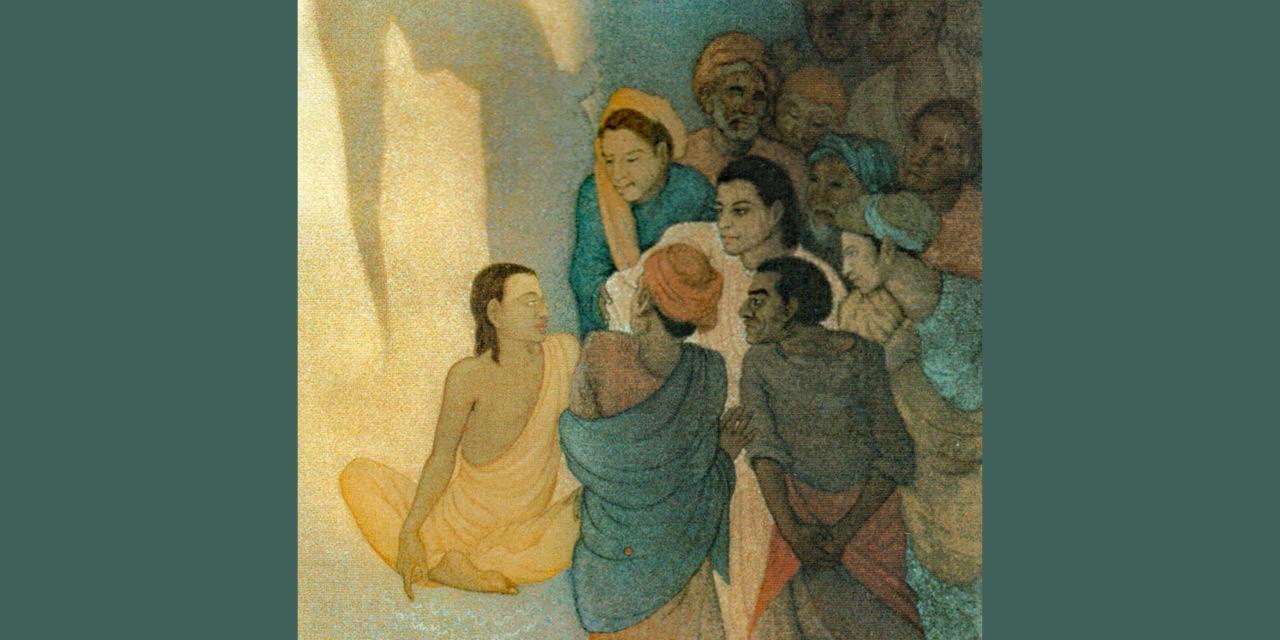 Sunggu Yang teaches homiletics at George Fox University in Newberg, Oregon, and is ordained in the Presbyterian Church (USA). He cofounded the e-journal Asian American Theological Forum and writes books and peer-reviewed academic articles. His most recent book is Arts and Preaching: A Handbook for Practice, Volume 1. In this edited conversation, Yang discusses what he learned while leading a 2023 Teacher-Scholar Grant on intra-dynamic preaching from the Calvin Institute of Christian Worship’s Vital Preaching, Vital Worship Grants program.
Sunggu Yang teaches homiletics at George Fox University in Newberg, Oregon, and is ordained in the Presbyterian Church (USA). He cofounded the e-journal Asian American Theological Forum and writes books and peer-reviewed academic articles. His most recent book is Arts and Preaching: A Handbook for Practice, Volume 1. In this edited conversation, Yang discusses what he learned while leading a 2023 Teacher-Scholar Grant on intra-dynamic preaching from the Calvin Institute of Christian Worship’s Vital Preaching, Vital Worship Grants program.
How would you describe your grant project?
The purpose was to explore multidimensional preaching practices that meet listeners’ need to see, taste, feel, and even touch the compelling word of the triune God. I gathered a cohort of regular preachers and preaching professors to discuss the theory of intra-dynamic preaching. We agreed on a chapter format for each cohort member to follow. The result was a handbook to help preachers become more oriented to engaging contemporary listeners through the arts.
What is intra-dynamic preaching?
The intra-dynamic mode of artistic preaching refers to a method in which the form and language of the sermon are artistically shaped by the very art form that inspires it rather than merely referencing or illustrating that art. In this approach, the sermon itself becomes a kind of artistic expression—fashioned like a garment, for example, if fashion is the guiding metaphor.
The preacher doesn’t just talk about fashion or use it to support a message; instead, fashion becomes the mode and theology of the sermon’s structure and delivery. In this mode, the sermon is not simply an analytical exposition, but an embodied aesthetic act. The preacher metaphorically “embroiders” the sermon so that it can be “worn” by the listener—meaning the sermon becomes something experientially inhabitable, not just intellectually received. This makes intra-dynamic preaching more immersive, evocative, and transformative, where art and theology are not separate, but one and the same.
What is the “sense of mysterium” that intra-dynamic preaching aims to evoke?
A “sense of mysterium” in preaching and worship refers to the encounter with the holy that evokes both awe and intimacy—what German Lutheran philosopher Rudolf Otto called mysterium tremendum et fascinans. Preaching, from this view, is not just interpretation or application of scripture, but a sacred event that draws people into mystery and transformation.
This contrasts sharply with a strictly historical-critical method, which focuses on analyzing a text’s historical origins, language, and cultural background. In contrast, a holistic-artistic or aesthetico-holistic approach seeks to unite the head, heart, and imagination—bringing together theology, aesthetics, emotion, and embodiment. While we used the term “holistic-artistic” in the handbook, we use “aesthetico-holistic” in the website companion to the handbook. This reflects a deeper emphasis on aesthetic experience as central to the holistic preaching event, not just artistic technique. Aesthetic in this sense includes not only art, but perception, beauty, and existential resonance.
What’s the difference between your first and second books on the arts and preaching?
The 2021 book, Arts and Preaching: An Aesthetic Homiletic for the Twenty-first Century, is a theoretical and theological proposal. It outlines the rationale and methodology for an aesthetic homiletic rooted in theological aesthetics, Spirit-attentiveness, and the lived experience of preaching as an art form. Its primary audience is scholars, seminary instructors, and advanced students of homiletics who want a framework for preaching that moves beyond propositional content into the territory of image, beauty, mystery, and embodiment. It engages more deeply with postmodern thought, theories of beauty, and the limits of rationality in preaching.
 In contrast, Arts and Preaching: A Handbook for Practice, Volume 1 is more practical and accessible. It offers concrete examples of sermons inspired by various art forms—visual art, architecture, fashion, film, and theater—and includes commentary on each art form. The audience here is broader: pastors, students, and workshop leaders. Readers do not need to have read the 2021 book to understand the handbook, though doing so would provide a richer theological grounding. The handbook is more readable, hands-on, and application-focused, while the 2021 volume is more foundational, conceptual, and philosophically dense. Together, they form a coherent whole: the theory followed by practice.
In contrast, Arts and Preaching: A Handbook for Practice, Volume 1 is more practical and accessible. It offers concrete examples of sermons inspired by various art forms—visual art, architecture, fashion, film, and theater—and includes commentary on each art form. The audience here is broader: pastors, students, and workshop leaders. Readers do not need to have read the 2021 book to understand the handbook, though doing so would provide a richer theological grounding. The handbook is more readable, hands-on, and application-focused, while the 2021 volume is more foundational, conceptual, and philosophically dense. Together, they form a coherent whole: the theory followed by practice.
What inspired you to develop this alternative mode of preaching?
A key twenty-first-century shift prompting this new approach is the decline of linear, rational discourse as the dominant mode of communication. Audiences today, especially younger generations, are shaped more by visual, emotional, and experiential media than by print culture.
Sermons that rely on logical three-point outlines, for instance, often fail to engage or transform. In response, aesthetico-holistic preaching embraces embodied storytelling, metaphor, symbol, and aesthetics to resonate with how people now encounter meaning. The approach was born out of a desire to preach with and to the whole person, acknowledging how imagination, beauty, and emotion shape faith in profound ways.
Please give examples of how the form and language of an art can shape a sermon.
Two people who contributed to the handbook took the John 8 story of the woman caught in adultery as their sermon text. Eliana Ah-Rum Ku, who teaches preaching at the Graduate School of Practical Theology in Seoul, South Korea, wrote the fashion chapter. She uses fashion to explore the vulnerability and strength revealed through the clothing choices in scripture and in the preacher’s own wardrobe. Her fashion-informed sermon focuses on visibility, shame, and dignity—inviting listeners to “see” how clothing (literal and metaphorical) defines one’s identity.
Rob O’Lynn teaches preaching and ministry and directs graduate Bible programs at Kentucky Christian University in rural Grayson, Kentucky. In his theater chapter, he emphasizes gesture, silence, and the staging of scripture in such a way that the congregation feels they are within the biblical drama. His theater-informed sermon plays with dramatic timing, spatial relationships, and voice to emphasize interruption, grace, and transformation. For example, when Jesus stooped to write in the sand, he interrupted the accusers’ focus on the woman.
How does your handbook break new ground?
Examples of marrying the art of preaching with the power of artistic expression abound in the handbook. In these cases, preaching doesn’t just describe the gospel, but performs it, incarnating its power through the preacher’s body, tone, movement, and art-infused sermon structure. This convergence invites both preacher and congregation into a participatory encounter with God. Each approach highlights different aspects of the text, showing how art forms not only influence style but also deepen interpretation and embodied meaning.
Are there barriers to intra-dynamic preaching?
Yes, barriers to learning and preaching in this way are real. Many preachers have been trained to prioritize doctrinal accuracy or the expository method over spiritual aesthetics. They may feel uncertain or ill-equipped to engage with the arts, fearing that artistic integration might dilute theological content. Congregants often respond to intra-dynamic sermons with surprise, appreciation, or even transformation—though some may initially be unsure how to categorize such a sermon.
Importantly, listeners do not need to intellectually identify the art form used; rather, they intuitively experience its impact. A congregation doesn’t need advanced education to understand this preaching, but the preacher must guide them with clarity and care. Some sermons featured in the handbook were indeed preached, and the responses were generally positive—engagement, tears, reawakened faith, and deeper conversation followed.
Are you suggesting that preachers should always use the intra-dynamic mode?
No. Expository sermons and narrative sermons have strong merits. And, after encountering God in the sermon text, the preacher doing an intra-dynamic sermon must still do historical-critical exegesis and may include storytelling. As I suggest in the handbook, even one intra-dynamic sermon per liturgical season can have a lasting impact. Intra-dynamic preaching seeks to incarnate all the experiences or mysterium tremendum that happened when God acted or spoke or put into the oral telling of the scriptures that were eventually written down.
Do you plan to offer more examples of how art forms can shape intra-dynamic sermons?
Thanks to a 2024 CICW grant, my project team is currently working on Arts and Preaching: A Handbook for Practice, Volume 2. In this volume, we will explore five additional art forms: photography, dance, comics, storytelling, and music. We anticipate that it will be released in early 2027. Upon its publication, we hope to begin work on Volume 3 (likely the final volume in the series). In the meantime, the website www.preachingcenter.org will continue to be updated with additional resources—video clips, articles, books, artworks, and more.
Learn More
Arts and Preaching: An Aesthetic Homiletic for the Twenty-first Century, by Sunggu A. Yang, lays out the theory of intra-dynamic homiletics. Its extensive appendix includes a syllabus that teachers can use or adapt to train student preachers.
In Arts and Preaching: A Handbook for Practice, Volume 1, edited by Sunggu A. Yang, five preachers or preaching professors describe how the form and language of a specific art form—cubist painting, architecture, fashion, film, or theater—can be used to shape a sermon. Each chapter includes a sample sermon.
Explore The CAP Center for All Preachers, a website developed as part of Yang’s 2023 Teacher-Scholar Grant from the Calvin Institute of Christian Worship’s Vital Grants, Vital Preaching Grants program.

